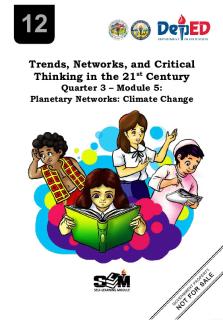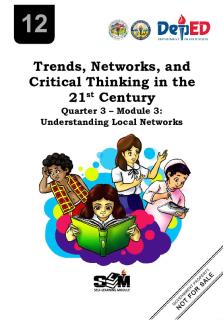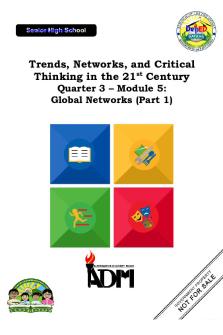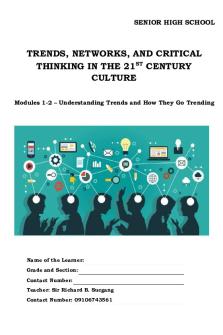Module 5: Planetary Networks: Climate Change ,Trends, Networks, and Critical Thinking in the 21st Century Quarter 3 – PDF

| Title | Module 5: Planetary Networks: Climate Change ,Trends, Networks, and Critical Thinking in the 21st Century Quarter 3 – |
|---|---|
| Course | 21ST Century |
| Institution | Tagum City National High School |
| Pages | 32 |
| File Size | 1.1 MB |
| File Type | |
| Total Downloads | 450 |
| Total Views | 874 |
Summary
Download Module 5: Planetary Networks: Climate Change ,Trends, Networks, and Critical Thinking in the 21st Century Quarter 3 – PDF
Description
12 Trends, Networks, and Critical Thinking in the 21st Century Quarter 3 – Module 5: Planetary Networks: Climate Change
Trends, Networks, and Critical Thinking in the 21st Century – Grade 12 Quarter 3 – Module 5: Planetary Networks: Climate Change First Edition, 2021 Republic Act 8293, section 176 states that: No copyright shall subsist in any work of the Government of the Philippines. However, prior approval of the government agency or office wherein the work is created shall be necessary for exploitation of such work for profit. Such agency or office may, among other things, impose as a condition the payment of royalties. Borrowed materials (i.e., songs, stories, poems, pictures, photos, brand names, trademarks, etc.) included in this module are owned by their respective copyright holders. Every effort has been exerted to locate and seek permission to use these materials from their respective copyright owners. The publisher and authors do not represent nor claim ownership over them. Published by the Department of Education Development Team of the Module Writer: April Mae Y. Asis Editor: Leonard P. Dahunog Reviewer: Noel G. Escobal Management Team: Josephine L. Fadul – Schools Division Superintendent Melanie P. Estacio - Assistant Schools Division Superintendent Christine C. Bagacay – Chief – Curriculum Implementation Division Darwin F. Suyat – Education Program Supervisor – English Lorna C. Ragos - Education Program Supervisor Learning Resources Management
Printed in the Philippines by Department of Education – Region XI Office Address:
Energy Park, Apokon, Tagum City, 8100
Telefax:
(084) 216-3504
E-mail Address:
[email protected]
i
12 Trends, Networks, and Critical Thinking in the 21st Century Quarter 3 – Module 5: Planetary Networks: Climate Change
Introductory Message This Self-Learning Module (SLM) is prepared so that you, our dear learners, can continue your studies and learn while at home. Activities, questions, directions, exercises, and discussions are carefully stated for you to understand each lesson. Each SLM is composed of different parts. Each part shall guide you step-by -step as you discover and understand the lesson prepared for you. Pre-tests are provided to measure your prior knowledge on lessons in each SLM. This will tell you if you need to proceed on completing this module or if you need to ask your facilitator or your teacher’s assistance for better understanding of the lesson. At the end of each module, you need to answer the post-test to self-check your learning. Answer keys are provided for each activity and test. We trust that you will be honest in using these. In addition to the material in the main text, Notes to the Teacher are also provided to our facilitators and parents for strategies and reminders on how they can best help you on your home-based learning. Please use this module with care. Do not put unnecessary marks on any part of this SLM. Use a separate sheet of paper in answering the exercises and tests. And read the instructions carefully before performing each task. If you have any questions in using this SLM or any difficulty in answering the tasks in this module, do not hesitate to consult your teacher or facilitator. Thank you.
iii
Let Us Learn This module brings you to the real scenario of the condition brought about by climate change. It helps you understand the consequences of one’s action on how consumption and production patterns affect climate change. It will further discuss the effects and the steps to address climate change. After going through this module, you are expected to: 1. Explain the effects of consumption and production patterns on climate change (HUMSS_MCT12-Ih-i-2) 2. Discuss personal contributions that can actually solve the problem of climate change (HUMSS_MCT12-Ih-i-3) 3. Make a stand on how the consequences of one’s action affect the lives of others and the environment (HUMSS_MCT12-Ih-i-4)
1
Let Us Try As an initial activity, you will be assessed on your prior knowledge. This is to find out what are the things you need to learn about the subject matter.
Direction: Write the letter of the correct answer in your answer sheet. 1. What causes the greenhouse effect? a) Greenhouse gases in the lower atmosphere absorbing solar radiation b) Greenhouse gases in the lower atmosphere absorbing radiation from the earth's surface, and preventing much of it escaping into space c) Too much heat in the atmosphere d) Too much sunshine reaching Earth 2. Which of the following activities contribute the most to carbon emissions globally? a) Energy Supply c) Agriculture b) Transport d) Forestry 3. What is NOT believed to be a cause global warming? a) Increase in greenhouse gases c) Burning fossil fuels b) Increase in human populations d) None of the above 4. Which particular effect of Global warming has affected many parts of earth? a) Cooler temperatures c) Season changes b) Melting ice d) None of the above 5. What global issue refers to the rise in average surface temperatures on earth due to the burning of fossil fuels? a) Climate change c) Ultraviolet rays b) El Niño d) Heat wave 6. Which of the following statements best describe the solutions to climate change? a) Stop down the cutting of trees b) Less use of the fossil fuels c) More consumption on energy d) Focused on the renewal energy 2
7. Which of these statements is the true cause of the greenhouse effect? a) Excess of nitrogen in the atmosphere b) Excess of carbon dioxide in the atmosphere c) Heat from the sun that reaches the surface of the earth d) All of the above 8. What a) b) c) d)
can you do to prevent climate change in your level? Drive your car less and use public transport Turn off the lights when not in use Recycle the materials All of the above
9. The following activities are the causes of climate change, EXCEPT? a) Rise of the sea levels c) Deforestation b) Burning of fossil fuels d) Food consumption 10. Which of the following statements is true about climate change? a) Global sea level is rising. b) Getting rid of fuel companies is the best solutions for climate change. c) Majority of the scientists agree that climate change is caused by natural phenomenon. d) Humans are insignificant to affect global climate.
3
Lesson
1
Effects of Consumption and Production Patterns on Climate Change
Let Us Study
Weather tells the environmental condition in a specific place. It can be rainy, sunny, windy or snowy while Climate describes the weather conditions expected in a particular place in a specific time of the year. Climate change refers to the significant change in the average conditions of temperature and rainfall in a particular region over a long period of time. An amazing scientific accord highlighted that global climate change is due primarily to the human use of fossil fuels that releases dioxide and alternative greenhouse gases into the air. The gases trap heat inside the atmosphere, which may have a variety of effects on ecosystems. the results square measure the following; (a) rising ocean levels, (b) severe weather events, and (d) droughts that render landscapes additional vulnerable to wildfires. It is already happening in our planet even before it is inhabited by humans but scientists have observed that changes nowadays are too unusual, making them more alarmed. For over 20,000 years, much of the European regions were covered with glaciers. Today, climate all over Europe is quite warmer compared to its condition 20,000 years ago. Globally, warming temperatures and changes in precipitation are observed. The results of all these climatic changes include: A. sea levels rising, B. fewer mountain glaciers, C. faster melting of the ice in Greenland, Antarctica and the Arctic, and D. changes in flower and plant blooming times. A lot of factors are contributory to the global climate change but scientists have agreed that human activities have been the biggest contributor to such change. Burning fuel in factories, cars and buses affects the earth’s natural greenhouse. The heat of the planet is trapped in the 4
atmosphere making the Earth warmer. This phenomenon is called the greenhouse effect. Both production and consumption of goods contribute to global warming. Production as in manufacturing utilizes technology that emits large amount of carbon in the atmosphere. Distribution of goods such as shipping and storage in warehouses and distribution centers also produces hydrofluorocarbons that contribute to the greenhouse effect. Consumption produces wastes especially non –biodegradable one that pollutes the atmosphere when disposed through burning which also releases carbons. The food consumption and production have a major impact on the surroundings. The means we have a tendency to consume has each direct and indirect impact on the surroundings. An example of this consumption is that the uses of energy in our homes like television radio, computer, cars and public utility jeepney that emit harmful gasses and caused pollution and increased emissions of greenhouse gases that results in global climate change. Consumption conjointly vie an indirect impact towards our surroundings from the assembly, process and transportation of the products that we have a tendency to consume daily. Examples of this production of goods we consume are the can goods, soft drinks, processed foods, shampoo and many more.. In association, with consumption and production pattern within the Philippines, the state of surroundings in our country along with the emissions of greenhouse gasses, indicators on pollution and also the generation of material discovered that each one indicators show environmental degradation all told the domains being assessed (Sta. Romana, 2017). Disadvantages A. Failing economy will have a domino effect on its trading partner in another counter. This is evident among the European Union in which bail-out was made to save an economically failing nation. B. Wealth and power are concentrated in the hands of small group of corporate elite putting smaller competitors in disadvantageous situation resulting to weakening of their business capability that usually ends up selling their business to bigger companies. 5
C. Introduction of international products and brand makes way for business domination of bigger and developed countries making the cultural exchange one-sided in favor of those who dominate the market. Six Ways Climate Change Will Affect PH Cities Pia Ranada January 22, 2014 Rappler.com El Niño, sea level rise, ocean acidification are just some scenarios PH cities face due to climate change. Manila, Philippines – Climate change is happening now and it is happening, not in far-flung corners of the world, but in human communities. Scientists say human activities are largely responsible for the continued increase in average global temperatures, which causes climate change. Global greenhouse gases emitted by the fossil fuel industry (which gives us electricity and fuels our cars) trap heat in the Earth’s atmosphere thus warming the entire planet. Philippine cities will likely to experience at least one of these effects of climate change: 1. More intense El Niño The El Niño phenomenon occurs when the surface of ocean waters on the southern Pacific becomes abnormally warm. The energy created by this warming is so great that it can create an imbalance in the weather in different parts of the world. In Southeast Asia, it can lead to abnormally dry conditions. El Niño can also make other weather events like storms highly unpredictable. Weather will have extreme highs and lows, making it “increasingly difficult to accurately predict weather patterns for purposes of planning and normal business operations,” says a WWF-Philippines study.
2. Sea surface temperatures to rise By the end of the century, sea surface temperatures are expected to rise by 1 to 4 degrees Celsius. This can lead to more powerful storms because storms get their strength from heat rising from the sea. 6
In the Philippines, 4 and 5 degrees Celsius spike above the normal sea surface temperature have been recorded. Warmer seas kill coral reefs and can thus lead to a decline in fish catch, putting food security in danger. 3. Ocean acidification The shift in the pH levels of our oceans can lead to widespread coral reef death. Because of the imbalance, shrimps are not able to develop skins, oyster cannot develop shells. Fish larvae may not be able to develop bones. This further endangers food security and the livelihood of fishermen. 4. Sea levels to rise by 4 to 6 meters Current data show an increase in sea surface heights. Scientists say this is due to the melting of ice sheets in northern portions of the globe like Antarctica and Greenland. Sea level rise by 4 to 6 meters can submerge low-lying communities like Tacloban City which stands 3 meters above sea level. 5. Tropical cyclones to intensify The creation of tropical cyclones is already being recorded in areas where the phenomenon had never been observed. On Nov. 8, 2013, Super Typhoon Yolanda (Haiyan), said to be the strongest storm in recorded history, devastated cities in the Visayas. 6. Rainfall, river flow, and flooding to intensify Monsoon rainfall in the Philippines will reach new highs and lows. Some parts of the country will experience an upward trend in rainfall while other parts will experience an intensification of drought. These two extreme poles of weather will make it more difficult for agriculture and aquaculture sectors which are highly dependent on weather. Philippine cities are already experiencing unprecedented amounts of rainfall. In Tacloban City, rainfall increased by 257% from 1998 to 2011. More rainfall will lead to more flooding and can trigger landslides in upland communities.
7
Let Us Practice Direction: True or False. Analyze each statement. Write Pak If the statement is true but if the statement is false write Ganern . Write your answer on the space provided. ________1. Scientists believe that as the Earth continues to warm up, we are experiencing weather-related disasters. ________2. When we burn fossil fuels we release oxygen and carbon dioxide in the air. ________3. Most of the harmful gases are released either by automobiles or power plants. ________4. The food consumption and production have no significant impact on the environment. ________5. Renewable energy is one of the possible solutions for climate change. ________6. Volcanic eruptions are natural event that affect the climate change. ________7. Agriculture activities contribute the most to carbon emissions globally. ________8. The increase of human populations is NOT believed to cause global warming. ________9. Climate change is the rise in average surface temperatures on Earth, mostly due to the burning of fossil fuels. ________10. Fossil fuels are natural fuel such as coal or gas, formed in the geological past from the remains of living organisms.
8
Let Us Practice More Direction: Examine the picture below. Observe every detail and answer the questions that follow. Write your answer on your answer sheet.
Source: http://www.foodsystemprimer.org/food-production/food-and-climate-change/
Guide Questions: 1. What may have caused the death of the cattle? 2. How can humans be contributory to the death of those cattle? 3. What can be done to prevent such event? Justify your answer.
Let Us Remember Direction: In 2-3 sentences, answer the given questions below. 1. What are the six ways climate change will affect the Philippines? 2. How could people deal with the effects of climate change? 3. What could be the potential solutions to climate change?
9
Let Us Assess Direction: Write C if the statement is the cause of climate change and E if its effect. _____________1. Burning of fossil fuels _____________2. Landslides _____________3. Deforestation _____________4. Food consumption _____________5. Public Utility Jeep _____________6. El Niño and La Niña _____________7. Manufacturing Industries _____________8. Factories _____________9. Rising of sea levels _____________10. Wildfires in the forest
Let Us Enhance Direction: List down manufacturing and production activities and give their harmful effects to the environment. Do this in your notebook Manufacturing and Production Activities
Harmful Environmental Activities
1. 2. 3. 4.
10
Let Us Reflect Direction: In writing your reflection, you have to complete the sentence below.
I learned that _____________________________________________________________ ___________________________________________________________________________ ___________________________________________________________________________ ___________________________________________________________________________
I realized that _____________________________________________________________ ___________________________________________________________________________ ___________________________________________________________________________ ___________________________________________________________________________
If given a chance __________________________________________________________ ___________________________________________________________________________ ___________________________________________________________________________ ___________________________________________________________________________
11
Lesson
2
Discuss personal contributions that can actually solve the problem of climate change
Let Us Study Paskill (2018) suggested eight (8) simple ways to help care our environment. In every little thing you make a difference. 1. Use Reusable luggage If you're attending to mall for searching like grocery, food, and garments you would like to apply the plastic luggage. Mistreatment reusable luggage helps the atmosphere. Plastic grocery-type luggage that get thrown out find yourself in landfills and it takes years to decompose. 2. Print as very little as Necessary Using such a lot paper is damaging to the atmosphere. If possible recycle the utilization writing paper for printing. If not, print on either side of the page to scale back the number of paper used. 3. Recycle Instead of throwing recyclables within the trash along with your nonrecyclables, recycle the materials of fine use. create a degree to require an additional step to separate reclaimable materials like cans, bottles, plastic and papers. 4. Use a Reusable nutrient Containers In most school, fruit juices is served mistreatment plastic cups, rather than shopping for this cup of drinks on an individual basis, deliberate to use a reusable bottle. Not solely can this facilitate the atmosphere it saves your money for several of the campuses that provide water fountains designed for drinking still as for replacement reusable water bottles.
12
5. Don’t Throw Your Notes Away Keeping your notes can facilitate the scholars by having the ability to scan what they're learning within the words of another student. If you can’t notice anyone to convey the notes to, at the terribly least, recycle the paper you used. 6. Save Electricity! Use energy-efficient light-weight bulbs rather than regular bulbs. They last longer, which can save your money. Make you turn off lights, the TV, and other appliances when you are not using them. 7. Save Water Water is wasted a lot frequently than we can see. Shut down the faucet as you're brushing your teeth. Don’t turn your shower on till you’re able to get in and wash your hair. Limit your water usage as you wash dishes. 8. Avoid Taking Cars or Carpool as possible Cars square measure harmful to the atmosphere. Taking public transportation, walking, or riding a motorcycle are better options that help the environment and your budget, as well as getting some exercise. Madaan (2018) also suggested that t...
Similar Free PDFs

Trends Networks Module 4
- 33 Pages

Networks
- 28 Pages

Marketing IN THE 21ST Century
- 10 Pages

Realism in the 21st Century
- 3 Pages

Climate Change - Module 10
- 15 Pages

Networks
- 2 Pages
Popular Institutions
- Tinajero National High School - Annex
- Politeknik Caltex Riau
- Yokohama City University
- SGT University
- University of Al-Qadisiyah
- Divine Word College of Vigan
- Techniek College Rotterdam
- Universidade de Santiago
- Universiti Teknologi MARA Cawangan Johor Kampus Pasir Gudang
- Poltekkes Kemenkes Yogyakarta
- Baguio City National High School
- Colegio san marcos
- preparatoria uno
- Centro de Bachillerato Tecnológico Industrial y de Servicios No. 107
- Dalian Maritime University
- Quang Trung Secondary School
- Colegio Tecnológico en Informática
- Corporación Regional de Educación Superior
- Grupo CEDVA
- Dar Al Uloom University
- Centro de Estudios Preuniversitarios de la Universidad Nacional de Ingeniería
- 上智大学
- Aakash International School, Nuna Majara
- San Felipe Neri Catholic School
- Kang Chiao International School - New Taipei City
- Misamis Occidental National High School
- Institución Educativa Escuela Normal Juan Ladrilleros
- Kolehiyo ng Pantukan
- Batanes State College
- Instituto Continental
- Sekolah Menengah Kejuruan Kesehatan Kaltara (Tarakan)
- Colegio de La Inmaculada Concepcion - Cebu









